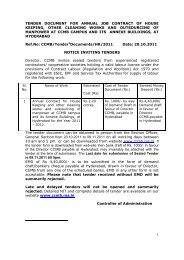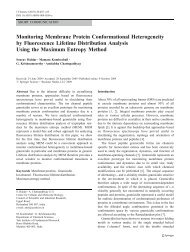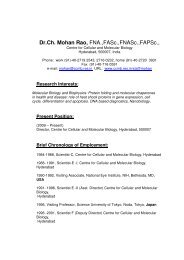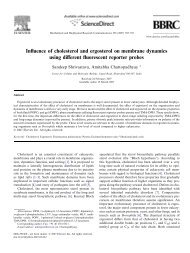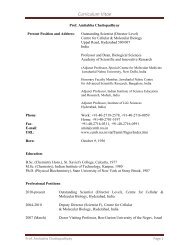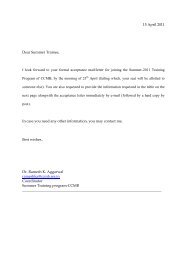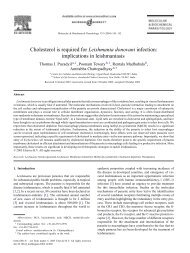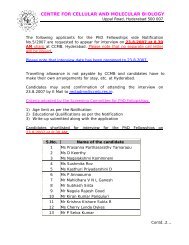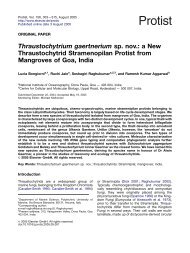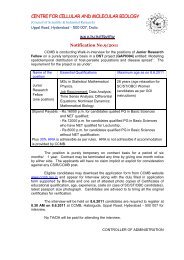Fibrillogenic and Non-fibrillogenic Ensembles of SDS ... - CCMB
Fibrillogenic and Non-fibrillogenic Ensembles of SDS ... - CCMB
Fibrillogenic and Non-fibrillogenic Ensembles of SDS ... - CCMB
You also want an ePaper? Increase the reach of your titles
YUMPU automatically turns print PDFs into web optimized ePapers that Google loves.
<strong>SDS</strong>-induced Fibril Growth <strong>of</strong> a-Synuclein10714. Arima, K., Ueda, K., Sunohara, N., Arakawa, K., Hirai,S., Nakamura, M. et al. (1998). NACP/alpha-synucleinimmunoreactivity in fibrillary components <strong>of</strong> neuronal<strong>and</strong> oligodendroglial cytoplasmic inclusions in thepontine nuclei in multiple system atrophy. ActaNeuropathol. (Berl), 96, 439–444.5. Wakabayashi, K., Hayashi, S., Kakita, A., Yamada, M.,Toyoshima, Y., Yoshimoto, M. et al. (1998). Accumulation<strong>of</strong> alpha-synuclein/NACP is a cytopathologicalfeature common to Lewy body disease <strong>and</strong> multiplesystem atrophy. Acta Neuropathol. (Berl), 96, 445–452.6. Weinreb, P. H., Zhen, W., Poon, A. W., Conway, K. A.& Lansbury, P. T., Jr (1996). A protein implicated inAlzheimer's disease <strong>and</strong> learning, is nativelyunfolded. Biochemistry, 35, 13709–13715.7. Uversky, V. N. (2002). What does it mean to benatively unfolded? Eur. J. Biochem. 269, 2–12.8. Jakes, R., Spillantini, M. G. & Goedert, M. (1994).Identification <strong>of</strong> two distinct synucleins from humanbrain. FEBS Letters, 345, 27–32.9. Iwai, A., Masliah, E., Yoshimoto, M., Ge, N., Flanagan,L., de Silva, H. A. et al. (1995). The precursor protein <strong>of</strong>non-A beta component <strong>of</strong> Alzheimer's disease amyloidis a presynaptic protein <strong>of</strong> the central nervoussystem. Neuron, 14, 467–475.10. Irizarry, M. C., Growdon, W., Gomez-Isla, T., Newell,K., George, J. M., Clayton, D. F. et al. (1998). Nigral <strong>and</strong>cortical Lewy bodies <strong>and</strong> dystrophic nigral neurites inParkinson's disease <strong>and</strong> cortical Lewy body diseasecontain alpha-synuclein immunoreactivity. J. Neuropathol.Expt. Neurol. 57, 334–337.11. Uversky, V. N., Cooper, E., Bower, K. S., Li, J. & Fink,A. L. (2002). Accelerated alpha-synuclein fibrillationin crowded milieu. FEBS Letters, 515, 99–103.12. Uversky, V. N., Li, J. & Fink, A. L. (2001). Evidence fora partially folded intermediate in alpha-synucleinfibril formation. J. Biol. Chem. 276, 10737–10744.13. Conway, K. A., Harper, J. D. & Lansbury, P. T., Jr(2000). Fibrils formed in vitro from alpha-synuclein<strong>and</strong> two mutant forms linked to Parkinson's diseaseare typical amyloid. Biochemistry, 39, 2552–2563.14. Conway, K. A., Lee, S. J., Rochet, J. C., Ding, T. T.,Williamson, R. E. & Lansbury, P. T., Jr (2000).Acceleration <strong>of</strong> oligomerization, not fibrillization, isa shared property <strong>of</strong> both alpha-synuclein mutationslinked to early-onset Parkinson's disease: implicationsfor pathogenesis <strong>and</strong> therapy. Proc. Natl Acad. Sci.USA, 97, 571–576.15. Conway, K. A., Harper, J. D. & Lansbury, P. T. (1998).Accelerated in vitro fibril formation by a mutantalpha-synuclein linked to early-onset Parkinson disease.Nature Med. 4, 1318–1320.16. Serpell, L. C., Berriman, J., Jakes, R., Goedert, M. &Crowther, R. A. (2000). Fiber diffraction <strong>of</strong> syntheticalpha-synuclein filaments shows amyloid-like crossbetaconformation. Proc. Natl Acad. Sci. USA, 97,4897–4902.17. Naiki, H., Higuchi, K., Matsushima, K., Shimada, A.,Chen, W. H., Hosokawa, M. et al. (1990). Fluorometricexamination <strong>of</strong> tissue amyloid fibrils in murine senileamyloidosis: use <strong>of</strong> the fluorescent indicator, thi<strong>of</strong>lavineT. Lab. Invest. 62, 768–773.18. Oberg, K., Chrunyk, B. A., Wetzel, R. & Fink, A. L.(1994). Native-like secondary structure in interleukin-1 beta inclusion bodies by attenuated total reflectanceFTIR. Biochemistry, 33, 2628–2634.19. Necula, M., Chirita, C. N. & Kuret, J. (2003). Rapidanionic micelle-mediated alpha-synuclein fibrillizationin vitro. J. Biol. Chem. 278, 46674–46680.20. Sharon, R., Goldberg, M. S., Bar-Josef, I., Betensky,R. A., Shen, J. & Selkoe, D. J. (2001). Alpha-Synuclein occurs in lipid-rich high molecular weightcomplexes, binds fatty acids <strong>and</strong> shows homology tothe fatty acid-binding proteins. Proc. Natl Acad. Sci.USA, 98, 9110–9115.21. Sharon, R., Bar-Joseph, I., Frosch, M. P., Walsh, D. M.,Hamilton, J. A. & Selkoe, D. J. (2003). The formation <strong>of</strong>highly soluble oligomers <strong>of</strong> alpha-synuclein is regulatedby fatty acids <strong>and</strong> enhanced in Parkinson'sdisease. Neuron, 37, 583–595.22. Perrin, R. J., Woods, W. S., Clayton, D. F. & George,J. M. (2001). Exposure to long chain polyunsaturatedfatty acids triggers rapid multimerization <strong>of</strong> synucleins.J. Biol. Chem. 276, 41958–41962.23. Jensen, P. H., Nielsen, M. S., Jakes, R., Dotti, C. G. &Goedert, M. (1998). Binding <strong>of</strong> alpha-synuclein tobrain vesicles is abolished by familial Parkinson'sdisease mutation. J. Biol. Chem. 273, 26292–26294.24. Davidson, W. S., Jonas, A., Clayton, D. F. & George,J. M. (1998). Stabilization <strong>of</strong> alpha-synuclein secondarystructure upon binding to synthetic membranes.J. Biol. Chem. 273, 9443–9449.25. Eliezer, D., Kutluay, E., Bussell, R., Jr & Browne, G.(2001). Conformational properties <strong>of</strong> alpha-synucleinin its free <strong>and</strong> lipid-associated states. J. Mol. Biol. 307,1061–1073.26. Perrin, R. J., Woods, W. S., Clayton, D. F. & George,J. M. (2000). Interaction <strong>of</strong> human alpha-Synuclein<strong>and</strong> Parkinson's disease variants with phospholipids.Structural analysis using site-directed mutagenesis.J. Biol. Chem. 275, 34393–34398.27. Jo, E., McLaurin, J., Yip, C. M., St. George-Hyslop, P. &Fraser, P. E. (2000). alpha-Synuclein membrane interactions<strong>and</strong> lipid specificity. J. Biol. Chem. 275,34328–34334.28. Zhu, M. & Fink, A. L. (2003). Lipid binding inhibitsalpha-synuclein fibril formation. J. Biol. Chem. 278,16873–16877.29. Ch<strong>and</strong>ra, S., Gallardo, G., Fern<strong>and</strong>ez-Chacon, R.,Schluter, O. M. & Sudh<strong>of</strong>, T. C. (2005). Alphasynucleincooperates with CSPalpha in preventingneurodegeneration. Cell, 123, 383–396.30. Bisaglia, M., Tessari, I., Pinato, L., Bell<strong>and</strong>a, M.,Giraudo, S., Fasano, M. et al. (2005). A topologicalmodel <strong>of</strong> the interaction between alpha-synuclein<strong>and</strong> sodium dodecyl sulfate micelles. Biochemistry,44, 329–339.31. Lee, J. C., Langen, R., Hummel, P. A., Gray, H. B. &Winkler, J. R. (2004). Alpha-synuclein structures fromfluorescence energy-transfer kinetics: implications forthe role <strong>of</strong> the protein in Parkinson's disease. Proc. NatlAcad. Sci. USA, 101, 16466–16471.32. Ulmer, T. S., Bax, A., Cole, N. B. & Nussbaum, R. L.(2005). Structure <strong>and</strong> dynamics <strong>of</strong> micelle-boundhuman alpha-synuclein. J. Biol. Chem. 280, 9595–9603.33. Lee, H. J., Choi, C. & Lee, S. J. (2002). Membraneboundalpha-synuclein has a high aggregation propensity<strong>and</strong> the ability to seed the aggregation <strong>of</strong> thecytosolic form. J. Biol. Chem. 277, 671–678.34. Lee, E. N., Lee, S. Y., Lee, D., Kim, J. & Paik, S. R.(2003). Lipid interaction <strong>of</strong> alpha-synuclein during themetal-catalyzed oxidation in the presence <strong>of</strong> Cu 2+ <strong>and</strong>H 2 O 2 . J. Neurochem. 84, 1128–1142.35. Narayanan, V. & Scarlata, S. (2001). Membranebinding <strong>and</strong> self-association <strong>of</strong> alpha-synucleins.Biochemistry, 40, 9927–9934.36. Munishkina, L. A., Phelan, C., Uversky, V. N. &Fink, A. L. (2003). Conformational behavior <strong>and</strong>




